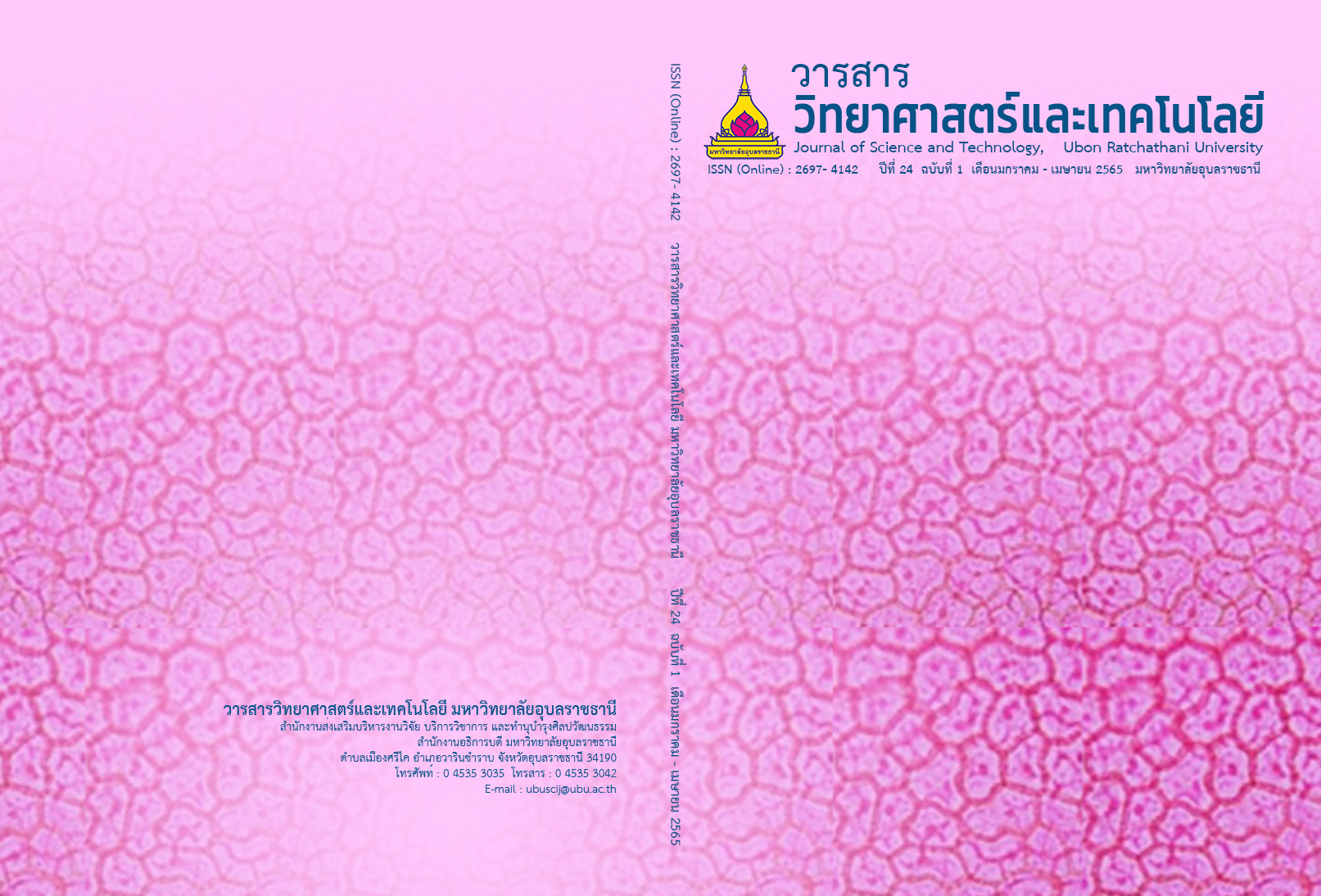กายวิภาคศาสตร์เนื้อเยื่อชั้นผิวใบเพื่อการระบุพืชสมุนไพรบางชนิดในมหาวิทยาลัยอุบลราชธานี
Main Article Content
บทคัดย่อ
กายวิภาคศาสตร์เนื้อเยื่อชั้นผิวใบจัดเป็นเครื่องมือสำคัญที่สามารถใช้ในการระบุชนิด การตรวจสอบสิ่งปลอมปน และใช้รับรองความถูกต้องของผงสมุนไพรได้ ดังนั้นวัตถุประสงค์ของงานวิจัยนี้เป็นการสร้างข้อมูลพื้นฐานและรูปวิธานแสดงความแตกต่างทางกายวิภาคศาสตร์ของพืชสมุนไพรบางชนิดในมหาวิทยาลัยอุบลราชธานี จังหวัดอุบลราชธานี ศึกษาโดยการลอกผิวใบของพืชสมุนไพรจำนวน 30 ชนิด จำแนกเป็น 28 สกุล 22 วงศ์ ย้อมด้วยสีซาฟรานินและจัดทำเป็นสไลด์ถาวร แล้วศึกษาลักษณะกายวิภาคศาสตร์ด้วยกล้องจุลทรรศน์แบบใช้แสงพร้อมบันทึกภาพถ่าย พบลักษณะเนื้อเยื่อชั้นผิวใบทั่วไปของพืชที่ศึกษาดังนี้ 1) ลวดลายของผิวเคลือบคิวทินเรียบและเป็นริ้วเรียงแบบขนาน 2) รูปร่างของเซลล์ในเนื้อเยื่อชั้นผิวเป็นแบบหลายเหลี่ยม รูปร่างไม่แน่นอน และรูปร่างคล้ายจิกซอว์ 3) ชนิดของปากใบเป็นแบบแอกทิโนไซติก แอนไอโซไซติก อะนอโมไซติก ไซโคลไซติก ไดอะไซติก พาราไซติก และเททระไซติก 4) ชนิดของขนเป็นแบบขนเซลล์เดียว และ 5) รูปแบบของสารสะสมเป็นผลึกรูปดาว ผลึกรูปปริซึม ผลึกรูปเข็ม เม็ดน้ำมัน สารสะสมติดสีแดง และโครงสร้างสารหลั่งเป็นแบบช่องสารหลั่ง ลักษณะดังกล่าวสามารถนำไปใช้สร้างรูปวิธานสำหรับการระบุชนิดของพืชที่ศึกษาและประยุกต์สำหรับการศึกษาทางเภสัชศาสตร์และชีววิทยาด้านอื่นที่ใกล้เคียงได้
Article Details

อนุญาตภายใต้เงื่อนไข Creative Commons Attribution-NonCommercial-NoDerivatives 4.0 International License.
บทความที่ได้รับการตีพิมพ์เป็นลิขสิทธิ์ของ วารสารวิทยาศาสตร์และเทคโนโลยี มหาวิทยาลัยอุบลราชธานี
ข้อความที่ปรากฏในบทความแต่ละเรื่องในวารสารวิชาการเล่มนี้เป็นความคิดเห็นส่วนตัวของผู้เขียนแต่ละท่านไม่เกี่ยวข้องกับมหาวิทยาลัยอุบลราชธานี และคณาจารย์ท่านอื่นๆในมหาวิทยาลัยฯ แต่อย่างใด ความรับผิดชอบองค์ประกอบทั้งหมดของบทความแต่ละเรื่องเป็นของผู้เขียนแต่ละท่าน หากมีความผิดพลาดใดๆ ผู้เขียนแต่ละท่านจะรับผิดชอบบทความของตนเองแต่ผู้เดียว
เอกสารอ้างอิง
Arambarri, A.M. and et al. 2006. Leaf anatomy of medicinal shrubs and trees from gallery forests of the Paranaense province (Argentina). Part 1. Boletin de la Sociedad Argentina de Botanica. 41(3-4): 233-268.
Stace, C.A. 1980. Plant Taxonomy and Biosystematics. London: Edward Arnold.
Khomkrit, T. 1998. Plant Anatomy. Bangkok: Kasetsart University Press. (in Thai)
Putiyanun, S. 1999. Identification of Medicinal Plants. Bangkok: War Veterans Organization Office of Printing Mill. (in Thai)
Judd, W.S. and et al. 1999. Plant Systematics. Massachusetts: Sinauer Associates.
Stuessy, T.F. 1990. Plant Taxonomy: The Systematic Evaluation of Comparative Data. New York: Columbia University Press.
Metcalfe, C.R. and Chalk, L. 1979. Anatomy of the Dicotyledons. Volume 1: Systematic Anatomy of Leaf and Stem, with a Brief History of the Subject. Oxford: Clarendon Press.
Venkateshwar, C. Rao, S.G. and Kumar, R. 2013. Epidermal study of medicinal plants with special reference to identification, adulteration and authentification of crude leaf drugs. Annals of Phytomedicine. 2(1): 115-125.
Munir, M. and et al. 2011. Foliar epidermal anatomy of some ethnobotanically important species of wild edible fruits of northern Pakistan. Journal of Medicinal Plants Research. 5(24): 5873-5880.
Idu, M., Erhabor, J.O. and Odia, E.A. 2009. Morphological and anatomical studies of the leaf and stem of some medicinal plants: Stachytarpheta jamaicensis (L.) Vahl. and S. cayennensis (L.C.Rich) Schau. Ethnobotanical Leaflets. 13: 1417-1425.
Santhan, P. 2014. Leaf structural characteristics of important medicinal plants. International Journal of Research in Ayurveda and Pharmacy. 5(6): 673-679.
Faculty of Pharmacy, Mahidol University. 1996. Traditional Herbs (1). Bangkok: Prachachon Co., Ltd. (in Thai)
Faculty of Pharmacy, Mahidol University. 2000. Traditional Herbs (5). Bangkok: Prachachon Co., Ltd. (in Thai)
Johansen, D.A. 1940. Plant Microtechnique. New York: McGraw Hill.
Lersten, M.R. and Curtis, J.D. 2001. Idioblast and other unusual internal folia secretory structures in Scrophulariaceae. Plant Systematics and Evolution. 227: 63-73.
Ramassamy, V. and Kannabiran, B. 1995. Stomata on earlier origin; morphology and ontogeny. Beitraege Zur Biologie Der Pflanzen. 68: 1-9.
Naik, V.N. and Nirgude, S.M. 1981. Anatomy in relation to taxonomy of Chlorophytum (Liliaceae). Indian Journal of Botany. 4(2): 48-60.
Essiett, U.A. and Etukudo, I.S. 2012. Leaf epidermal studies of three species of Acalypha L. (Euphorbiaceae). Advances in Applied Science Research. 3(5): 3185-3199.
Adedeji, O. and Jewoola, O.A. 2008. Importance of leaf epidermal characters in the Asteraceae family. Notulae Botanicae Horti Agrobotanici Cluj-Napoca. 36(2): 7-16.
Paliwal, G.S. 1969. Stomata ontogeny and phylogeny I. Monocotyledons. Acta Botanica Neerlanda. 18(5): 654-668.
Paula, J.R., Elisabeth, D.C. and Erin, C. 2017. Evolution and development of stomata. American Journal of Botany. 104(8): 1122-1141.
Zeiger, E., Farquhar, G.D. and Cowan, I.R. 1987. Stomatal Function. Stanford: Stanford University Press.
Xu, Z. and et al. 2016. Elevated-Co2 response of stomata and its dependence on environmental factors. Frontiers in Plant Science. 7: 657.
Wilmer, C. and Fricker, M. 1996. Stomata. 2nd edition. Suffolk: St Edmundsbury Press.
Uhl, D. and Walther, H. 2000. Sun leaf or shade leaf? Known facts in the light of new data with implications for palaeobotany. Feddes Repertorium. 111: 165-174.
Cookson, S.J. and Granier, C. 2006. A dynamic analysis of the shade-induced plasticity in Arabidopsis thaliana rosette leaf development reveals new components of the shade-adaptative response. Annuals of Botany. 97: 443-452.
Evert, R.F. 2006. Esu’s Plant Anatomy. Hoboken: John Wiley & Sons.
Promsing, J., Srinual, A. and Kesonbua, W. 2016. Leaf epidermal anatomy of some species of the Family Phyllanthaceae in Thailand. Journal of Science and Technology, Ubon Ratchathani University. 18(3): 87-99.
Inyama, C.N. and et al. 2015. Comparative morphology of the leaf epidermis in six Citrus species and its biosystematic importance. Medicinal & Amarotic Plants. 4: 194.
Fan, J. and et al. 2014. Systematic significance of leaf epidermal features in Holcoglossum (Orchidaceae). PLoS One. 9(7): e101557.
Venkateshwar, C., Rao, S.G. and Kumar, R.S. 2013. Epidermal study of medicinal plants with special reference to identification, adulteration and authentification of crude leaf drugs. Annals of Phytomedicine. 2(1): 115-125.


